HISTORY LINKS Launch day 1967 Timelines- 1966 1967 1968 1969 1970 1971 1972 1973 1974 1975 1976 1977 1978 to 1992 1993 to 1997 Original Presenters Logos Merchandise R Times Cuttings -1960's 1970's 1980's Listings - 1960's 1970's 1980's 1990's Campaigns & O.B's Transmitters Egton House  One-derful Story One-derful Story
Main Events It was established in London on 30th September 1967 following the Marine Offences Act 1967 which outlawed the unregulated pirate ship and fort radio stations broadcasting to Britain from the sea such as Radio London, Caroline, Swinging Radio England, Scotland, 270, 390, 355, BBMS, and land based Radio Jackie. These had been broadcasting pop music with jingles and commercials in an American style to highly populated coastal areas of the UK since 1964. The first pirate ship was Radio Caroline, which opened March 28th 1964. There was strong public pressure, including public demonstrations, to keep them 'on the air', however these stations were unregulated and did not pay any fees to the music artistes. The BBC and Government were embarrassed by the large listening figures gained by these and continental station Radio Luxembourg. Although Britain's pop industry was selling records worldwide, following the banning of the pirate stations there was little airtime provided to these acts because at this time, the BBC only had three national radio stations;    NAME | MAIN WAVELENGTHS | PROGRAMME CONTENT | Light Programme (founded 1945) | MW 247m, (1214 kHz) LW 1500m, (200kHz) VHF 88-91Mhz | Easy Listening/Comedy/Pop | Home Service (founded 1939) | MW 330m, (909Khz) VHF 93-95 MHz | News/Discussion/Plays | Third Programme (founded 1947) | MW 464m, (647kHz) VHF 91-93MHz | Classical Music |
The BBC Light programme broadcasted mainly instrumental 'sweet' music, chart hits were often re-sung by other artistes or an instrumental version was played, instead of the original single. This was due in part to the restrictions of needle-time (until 1967 the Phonographic Performance Ltd. only allowed the BBC 5 hours per day of commercial gramophone records playing on air). Dedicated pop music programmes were limited. Although an increasing number of popular records were aired on the channel from 1965, chart fans relied on the occasional chart disc played by disc jockeys such as Pete Murray, and the weekly Sunday 'Top Twenty' (Pick of the Pops) Alan Freeman (6.00-7.00pm). The BBC lacked a dedicated popular music station. 
The Government prepared a plan for replacing the pirates when the Bill outlawing them came into force. The Postmaster General, Edward Short, asked the BBC to create a 'Popular Music Service' on 247m during the hours outside peak-viewing of television. The BBC reported in August 1966 that they were finalising plans for a 24-hour radio music station to replace the condemned pirate "pop" ships. It was originally to be called Radio 247, (name favoured by Controller Robin Scott) aimed to attract the millions then listening to pirate broadcasts. It would use all the present music programmes broadcast by the Light Programme, including Housewifes' Choice and Double Spin. But when the Light broadcast talks or drama, such as Radio Newsreel or The Dales, Radio 247 would put in music and leave the main service to the Light Programme 1,500-metre waveband. But, the BBC stated, Radio 247 would not be all "pop." It would carry news headlines and 'occasional classical music'. Edward Short announced in Parliament on June 30th 1967 the BBC would open their new 'pop channel' on September 30th. The station would broadcast continuous pop music from 7AM to 7.30 PM followed by light music and entertainment until 2AM. On July 27th 1967, the BBC Director of Radio, Frank Gillard, announced plans to 'kill off' the Light Programme, Home Service and Third Programme. In future it would be 'Radio by Numbers'. The BBC Light Programme controller Robin Scott said 'hundreds' of D.J.'s would be interviewed for Radio 1, primarily pirate presenters because of their experience. On September 4th 1967, the D.J.'s and their shows were announced. Contracts were for 8 weeks, as opposed to the normal 13 weeks. Scott also pointed out that they had more D.J.'s than required, so there would eventually be a 'shake down' where only the best presenters would survive. In 1967 after further BBC deliberation, and a mammoth amount of media publicity, new names were given to the above stations and 'Radio 1' was born, using the 16 existing medium-wave relay transmitters of the Light Programme on 247m 1214Khz. The Light Programme was renamed Radio 2 using the long wave and FM frequencies. The 'Third Programme' was renamed Radio 3 and the 'Home Service' became Radio 4. 
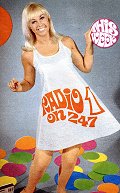
| 'Dolly bird' on front cover of 1967 Radio Times CLICK FOR DETAILS | 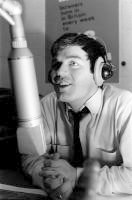
| Tony Blackburn on the first Radio 1 show. CLICK PICTURE TO SEE MORE & RECORD LIST |
Radio One first went on the air at 7am, September 30th 1967. However, many parts of the UK could not gain satisfactory reception, especially North Devon, Scotland, Mid/West Wales and North Cornwall. AM reception problems were increased during darkness. 
At Broadcasting House, London, announcer Paul Hollingdale opened the BBC Light Programme for the final time at 5.30AM on 30th September with 'Breakfast Special'. Continuity studios A and B were packed with pressmen, staff and well wishers. Controller Robin Scott moved to studio 'A' to prepare for the takeover from Paul Hollingdale. The new especially written Radio 1 theme tune, 'Theme One' (by the George Martin Orchestra) was played. A few seconds before 7AM he announced "Ten seconds to go before Radio 1....stand by for switching......five, four, three, Radio 2, Radio 1, GO! The first DJ was Tony Blackburn presenting the new show 'Daily Disc Delivery', and the first record played was 'Flowers In The Rain' by The Move. The signature tune for the show was called 'Beefeaters' by Johnnie Dankworth. The first live group were the Bee Gees, appearing on Saturday Club at 10AM. The first day only 5 hrs consisted of programmes being broadcast on Radio 1 alone, and there was a dissatisfaction from young listeners who had lost the offshore pirate radio stations (which, operating outside the law, did not have to observe the Phonographic Performance Ltd. 'needle time' regulations of 37 max hrs per week). Broadcasting on both networks was the Jimmy Young show (until 1973), The Sunday 'Top Twenty' and Late Night Extra. The BBC were only allowed to play 'commercial gramophone records' for 7 hours per day over both networks. Some 'dual station' broadcasts continued until 1979, when Radio 2 became the first UK national 24 hour radio station. Unfortunately, Radio 1 was the only of the four networks not to have a Stereo FM frequency allocated, and this was the case for 21 years. The official reason for this omission was that there was insufficient space on the FM dial, although there were no licensed Independent commercial stations at the time. Radio One was, however, allocated FM instead of Radio Two on Saturday Afternoons, Sunday Evenings (1 Hour), Weekday evenings (10pm to Midnight) and UK Bank Holidays, until when, in 1988 a frequency range of 97-99Mhz was allocated as the UK Police relay transmitters were moved from the 100mHz FM Frequency. Despite these setbacks, Radio 1 hit the ground running and doubled the Light Programme audience within the first month of launch. 
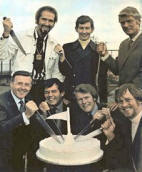
| | Radio 1 Presenters 'Cut the Cake' to celebrate the1st birthday of R1 CLICK PICTURE FOR LARGER IMAGE | |
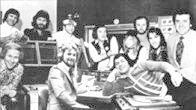
| NEW CLICK PICTURE FOR MORE IMAGES |
From its inception and throughout the 1970's and 1980's BBC Radio 1 was hugely successful, commanding weekly audiences of up to 24 million listeners. The now famous 'Radio 1 Roadshow' (launched 1973) toured Britain's holiday resorts through the Summer. The Roadshows were broadcast live on-air. Disc-jockeys such as Noel Edmonds and Dave Lee Travis became famous in the UK. The daytime music format of the station was one of chart pop music, whilst evening programmes reflected up-and coming bands, rock and new-wave music. The Station Controller, Johnnie Beerling, had helped to make the station well - loved by its listeners by appealing to all age groups. The network established transmissions from 6 am - 12 midnight every day in January 1979 when the station became totally separated from Radio 2. The 'Live Aid' concert, the decade's major rock event, was broadcast in full on Radio One July 1985. The station began a 24hr service in May 1991. Radio 1 was re-named '1FM' from August 1992 until mid-1995. 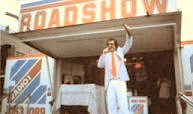
|
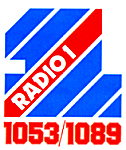 Although Radio 1 was Britain's most listened to radio station, following much speculation, it was determined in 1993 by BBC Director General John Birt that the station was not sufficiently different and distinctive from the commercial opposition. That year, the target audience was changed from 13-40 to 13-25. A new Station Controller, Matthew Bannister, was appointed who was to carry out the changes to make Radio One more elitist. Many of the popular DJ's were sacked or resigned because of the policy change. These included Simon Bates, Dave Lee Travis and Gary Davies. Fifteen were to leave in total. The listening figures dropped from 16.5 million per week (15 years or over) in February 1993 to only 11 million in the last quarter of 1994. Although Radio 1 was Britain's most listened to radio station, following much speculation, it was determined in 1993 by BBC Director General John Birt that the station was not sufficiently different and distinctive from the commercial opposition. That year, the target audience was changed from 13-40 to 13-25. A new Station Controller, Matthew Bannister, was appointed who was to carry out the changes to make Radio One more elitist. Many of the popular DJ's were sacked or resigned because of the policy change. These included Simon Bates, Dave Lee Travis and Gary Davies. Fifteen were to leave in total. The listening figures dropped from 16.5 million per week (15 years or over) in February 1993 to only 11 million in the last quarter of 1994.
Radio 1 lost its AM 1053/1089KHz (275/285m) frequencies at 9AM on the 1st July 1994 listen in! due to a Government Bill to encourage commercial radio competition on AM. In many areas of the country car radio reception is poor on FM. 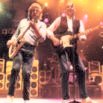
| | STATUS QUO - BANNED FROM RADIO 1 | |
The new Disc Jockey's were compelled to stick to a rigid playlist which tended towards 'Britpop' rock oriented and less 'Top 40'. The station's music policy in 1994 became mainly bands such as Oasis. Blur, Happy Mondays; Status Quo and The Beatles were banned and in fact no records older than 5 years were allowed. Since 1996 the station has given a significant amount of airtime to dance music (DJ's Tong, Trevor Nelson, Judge Jules - and also daytime playlist) and with the 'One Big Sunday' dance Roadshows. Jungle and rap is broadcast by night at weekends, leaving those listeners not part of the dance/clubbing culture feeling uncatered for. April 1997 saw Radio 1 launching their first website. The station newer daytime DJ's e.g. Moyles, Cox, Mark and 'Lard' (and formerly Chris Evans) discuss subjects on-air not always suitable for a younger audience and have been criticised for promoting 'laddish' behaviour. Unfortunately, following the loss of the popular format, Radio 1 is no longer 'Britain's Favourite Radio'. This accolade has, since May 2001, belonged to BBC Radio 2, with a target audience of 45 years +. 
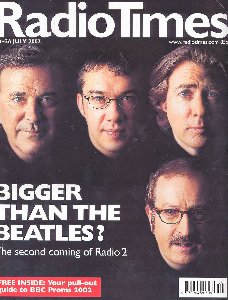
| RADIO TIMES COVER 20th JULY 2002 |
Just tune in to Radio 2 on a Saturday; having handed sports coverage to Radio Five, the 'pipe and slippers' channel broadcasts a format similar to that of early 90's Radio 1, with cheeky Jonathan Ross, - Paul Gambaccini's US hits and uncle Bob Harris - often an evening live rock concert is broadcast. The general style of Saturday programming could almost be early 90's Radio 1 except for the jingles. The former Light Programme also cheerfully transmits Steve Wright, Johnnie Walker and Simon Mayo, who presents a weekly album chart review. That is not to say Radio 1 completely lives on under the guise of Radio 2; their weekday mornings, evenings and Sunday playlist/presentation style remains very Light Programme and shows little sign of imminent change. While Radio 2 continues to be moulded into a clone of an earlier populist Radio 1, where will the traditional Radio 2 listener turn... |